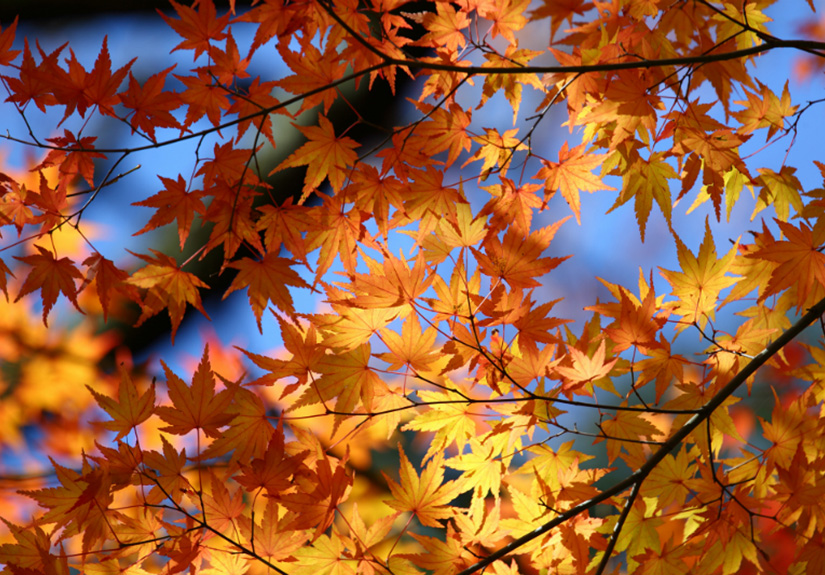Insightful Tips from Travel Photographer: In Search for the Best Shot of Red Leaves
Red leaves become the talk of town every year when autumn arrives. It is a peak season for photo lovers to travel abroad and admire the fascinating beauty of golden leaves in the mountains and nature. In this article, founder of Facebook fan page “旅?攝” and photographer Henry Lo will share his tips and experience in red leaves photography. As he said, “Skill is important, but it is not as important as your determination, passion and patience in searching for the best angle to capture the best of red leaves.”

Travel Tips and Experience Sharing on Facebook Fan Page
Despite having multiple roles at work from being a promoter, freelancer to travel column writer in newspaper, Henry’s passion in photography and travel never fades. He has forged an indissoluble bond with camera 20 years ago, and has shared his travel photos and feelings through his blog. In mid-2012, he set up a Facebook fan page “travel.foto” to continue on the sharing and interaction with like-minded people. Maple leaves in autumn are something Henry won’t miss out every year. With footprints across 60 countries and over 250 cities, Henry highly recommended England, Japan and Korea for red leaves photography. “More popular destinations in the northern Europe include London and Manchester in England. For those who prefer closer in location can consider Japan. Korea is also a hot destination in recent years. Places like Naejangsan National Park and Daedunsan National Park are excellent shooting locations for maple leaves.”

Get the Latest News on Foliage Forecast before Departure
Photography is about timing. Since the viewing of red leaves is very much depend on the weather, it is important that you check the weather forecast before going. “Take Japan as an example. It is a large country and places are far from each other. If you travel for 3 days, say Friday till Sunday, you may swap your itinerary around depending on the weather condition.” Henry continued, “The autumn foliage season of Japan usually lasts from end of September till mid November and goes downward from the north. As a couple of typhoons visited Japan in October this year, the start of the foliage season was delayed for a week.” To avoid disappointment, Henry suggested that we could check the foliage information on websites like tourism organization where detailed foliage forecast of different regions and scenic spots would be shown.
For those who travel mainly for photographing red leaves, it is suggested that you plan your own trip or rent a car to ensure flexibility in itinerary. Keep an eye on the latest update of foliage. Book your flight tickets only when the leaves start to change colors and you will probably arrive at the best time to view and photograph red leaves. Henry added, “Autumn foliage is beautiful even before turning red. They are spectacular in different ways during the course of green leaves turning into brilliant shades of yellow, orange and red.”
For those who travel mainly for photographing red leaves, it is suggested that you plan your own trip or rent a car to ensure flexibility in itinerary. Keep an eye on the latest update of foliage. Book your flight tickets only when the leaves start to change colors and you will probably arrive at the best time to view and photograph red leaves. Henry added, “Autumn foliage is beautiful even before turning red. They are spectacular in different ways during the course of green leaves turning into brilliant shades of yellow, orange and red.”

Photo by Henry Lo
EOS 5D Mark III • EF 70-200mm f/2.8L IS II USM + 1.4x III • 1/250s • f/5.6 • ISO 160
EOS 5D Mark III • EF 70-200mm f/2.8L IS II USM + 1.4x III • 1/250s • f/5.6 • ISO 160
Explore Different Shooting Angles
When the vivid, beautiful autumn foliage scenery unfold before our eyes, sometimes we just can’t resist the urge to shoot. However, Henry reminded us to stay calm, take a second to observe and search for the best shooting angle before pressing the shutter. “I usually spend some time to observe outside the maple forest before entering and will pick the nicest bunch of leaves to shoot.” A nice background plays a key role in capturing close-up shots of the leaves on branches. Henry suggested that we could use a background in contrasting colors to the maple leaves, or shoot with back lighting to create photos with more depth by having the sunlight penetrating through the thin foliage to reveal its pattern.

When taking close-up shots of red leaves, we should observe first and focus on the nicest piece of red leaf on the branches. This requires one to be patient and observant
Photo by Henry Lo
EOS 5D Mark III • EF 70-200mm f/2.8L IS II USM + 1.4x III • 1/250s • f/5.6 • ISO 160
Photo by Henry Lo
EOS 5D Mark III • EF 70-200mm f/2.8L IS II USM + 1.4x III • 1/250s • f/5.6 • ISO 160

Position the leaf on a white background and shoot with back lighting for more outstanding result
Photo by Henry Lo
EOS 5D Mark III • EF 35mm f/2 • 1/800s • f/2.5 • ISO 125
Photo by Henry Lo
EOS 5D Mark III • EF 35mm f/2 • 1/800s • f/2.5 • ISO 125
The subject will appear darker when shooting with back lighting. The use of exposure compensation is thus necessary, but it would also affect the leaf colors. “When taking photos of green maple tree without any exposure compensation, the leaves will look darker than they really are. So we have to increase the exposure compensation to reveal their true colors. The same goes for photographing yellow maple leaves or else the colors will look dull and dark.” In addition to close-up shots, we can also create photos that tell a story by including the surrounding landmark and landscape in the composition when taking a wide shot of the distant scenery.

The black stones show a great contrast in color to the yellow leaf
Photo by Henry Lo
EOS 5D Mark III • EF 24-70mm f/2.8L USM • 1/100s • f/3.5 • ISO 125
Photo by Henry Lo
EOS 5D Mark III • EF 24-70mm f/2.8L USM • 1/100s • f/3.5 • ISO 125

Look down to the ground covered by fallen leaves in different shapes and size and you may also find something interesting to shoot
Photo by Henry Lo
EOS 5D Mark III • EF 24-70mm f/2.8L USM • 1/400s • f/2.8 • ISO 500
Photo by Henry Lo
EOS 5D Mark III • EF 24-70mm f/2.8L USM • 1/400s • f/2.8 • ISO 500
We usually use either a distant or close-up shot when taking portraits with red leaves, and it all depends on the scenery to see which one works better. “By shooting at the wide-end of a lens, you can photograph the full length of your subject but it will look tiny in the composition. This works well when you have spectacular, densely grown maple trees as the backdrop. On the contrary, if the place is crowded and trees are scattered, I would suggest taking half-length portraits using a telephoto lens. Be aware of the aperture to use, as a large aperture will result in shallow depth of field that may overly blur the red leaves in the background.”

The 4 most beautiful maple trees in the park. Henry had waited for almost half an hour to take this shot due to the crowd
Photo by Henry Lo
EOS 5D Mark III • EF 35mm f/2 • 1/200s • f/4 • ISO 250
Photo by Henry Lo
EOS 5D Mark III • EF 35mm f/2 • 1/200s • f/4 • ISO 250
Make Good Use of the Lens Characteristics to Create One-of-a-Kind Photos
Henry didn’t mind taking heavy travel bag and gear just for the sake of capturing more varieties in landscapes and topics. On his last trip to Nagano in Japan, Henry brought with him 1 camera and 5 lenses to accommodate different shooting needs. These included EOS 5D Mark III, EF 16-35mm f/2.8L II USM, EF 70-200mm f/2.8L IS II USM and EF 35mm f/2 IS USM etc. Henry added, “Use a wide angle lens to include the blue sky in your composition if the weather is good. To create photos with strong perspective compression, use a telephoto lens and frame your shot neatly to outstand the beauty of maple leaves.” In order to capture the best shot at the best timing, such as the beautiful sunrise moment, Henry once travelled overnight to the shooting location. “It may seem crazy to some people to travel day and night with heavy equipment just to take a picture. But for me, it is the most enjoyable and rewarding journey.”



